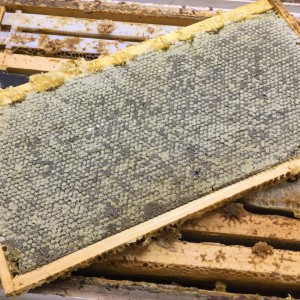How Honey is Made

‘In order to produce 1 pound of honey, 2 million flowers must be visited. A hive of bees must fly 55,000 miles to produce a pound of honey. One bee colony can produce 60 to 100 pounds of honey per year. An average worker bee makes only about 1/12 teaspoon of honey in its lifetime.‘ – Wikipedia.
When bees gather nectar from flowers, they collect the nectar in a special part called a honey stomach. It is brought back to the hive and transferred into the hexagon cells on the frame.
Hexagon Shape
I would like to mention there is a reason bees use the hexagon shape. The hexagon shape is the best shape for honey storage because it provides the most amount of storage space for the least amount of wax. Every hexagon cell shares walls with the neighboring cell and you have no gaps or wasted space. A hexagon is also one of the strongest shapes so it’s no surprise a frame of honey can contain 8 pounds of honey.
In 36 BC, a scholar, whose name was Marcus Terentius Varro concluded that the hexagon was the best suitable for honey storage. He was proven correct by modern mathematicians and the theory became known as the honeycomb conjecture.
“The honeycomb conjecture states that a regular hexagonal grid or honeycomb is the best way to divide a surface into regions of equal area with the least total perimeter.”
From Nectar to Honey

When the nectar is brought back to the hive, it can be anywhere from 50% – 90% moisture, much too wet for permanent storage. The bees will then dehumidify the nectar by fanning and pushing air into the hive from the outside. When the moisture becomes lower than 18.5%, it’s low enough for permanent storage as honey. Bees can sense this and will cover the cells containing ripe honey (honey with low moisture) with beeswax, which is waterproof. All cells with cured ripe honey, are coated and it is easily seen on the frames. The beekeeper can monitor the bees’ progress to see when it’s the right time to extract.
We can extract honey when the average frame has a 1/3 beeswax capping. The uncapped honey will balance with the capped giving you an adequate moisture reading. Most of our honey is around 17% moisture.
If you have a small amount of honey to extract, I would suggest waiting until most frames are properly sealed. Honey with moisture readings over 19 percent is at risk of fermentation where honey with low moisture reading can last indefinitely.